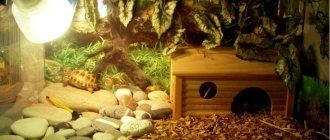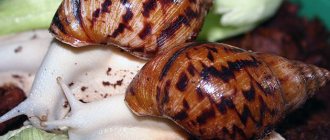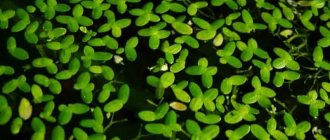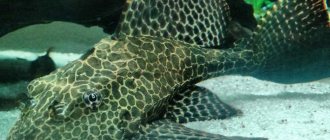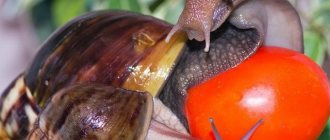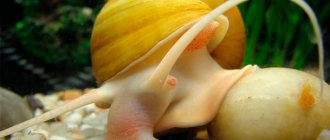Many people have heard about red-eared turtles, frequent inhabitants of terrariums. But few people know about their yellow-eared brothers. Today we will tell you about a rare species of yellow-eared turtles for Russian territory.
In nature, they live where there are marshy shores. Most often in shallow lakes and semi-flowing rivers of the United States.
It should be noted that the yellow-eared turtle is not a separate subspecies of the red-eared turtle, it is a completely different species. It is distinguished by a brighter color on the body of the shell. And instead of red ears, yellow ones. Turtles are considered quite rare in our country.
The aquaterrarium for a turtle should be at least 120 liters. The turtle's housing should be equipped with a heating lamp. The ideal temperature for her is 28 degrees.
What and how to feed a yellow-eared turtle
It is better to feed the yellow-eared turtle with turtle food, which is sold in pet stores. In general, these reptiles are considered predators and eat meat. But, if we take her at a young age, then we can accustom her to special food. A small turtle needs to be fed 2 times a day. When she grows up, food can be reduced to 1 time per day.
By the way, if you take your pet in your arms from an early age, they will soon get used to it and will begin to swim up to you every time. However, the pet can be picked up only when it is full.
Several fish fry are introduced into the turtle's aquaterrarium as additional food. You can decorate a turtle's home only with artificial plants, because the turtles will constantly feast on live algae. As a result, in a couple of weeks there will be nothing left of such decor.
This is the most basic knowledge that the future owner of a yellow-eared turtle should have.
Video - detailed menu of the proper diet for red-eared turtles:
Video on how to properly keep yellow-eared and red-eared turtles:
Reptiles as a pet are no longer something surprising. Therefore, information regarding the maintenance and care of the yellow-eared turtle is relevant for many.
To prevent misunderstandings, it is worth noting right away that the red-eared and yellow-eared turtles are different subspecies, so the features of their maintenance are slightly different. The external difference lies in the color of the ears - hence the name of the subspecies.
How to properly set up an aquarium for a yellow-eared turtle
In order for a turtle at home to please its owners for a long time and feel good, first of all it is necessary to choose and design the right aquarium for it.
Decorating a pet's future home begins with its purchase. Basic criteria for choosing an aquarium for a yellow-eared turtle:
- length is the most important parameter. The turtle needs space to swim. Do not forget that the size of the shell of an adult is about 20 cm;
- height - the animal must be able to swim, completely immersed in water. Additionally, you need a place to arrange a “dry” bed, it is necessary.
The bottom of the aquarium needs to be “covered” with pebbles and sand, which are sold in pet stores. Soil from a natural reservoir contains many microorganisms that can harm the turtle. The pebbles should be large enough so that the turtle cannot swallow them.
If you keep a turtle in a small aquarium, it will not stop growing! But the shell can become distorted, which causes a lot of pain for the animal.
Additionally, you can plant aquatic plants that are suitable for feeding the animal - they will become both a decoration for the aquarium and a treat for your pet.
Land can be presented in the form of an island built of pebbles, or a floating wooden bed. The main thing is that the turtle can easily climb into the dry house. Land should occupy at least 25% of the entire water area, one shore should smoothly go into the water. Another important point is that there should be no gaps between the glass and the island in which the pet could get stuck. The material should not be toxic - after all, it is used in conditions of elevated temperatures and high humidity.
Additional accessories for the aquarium:
- water heater;
- filter;
- thermometer;
- UV lamp;
- lamp;
- heating lamp.
It is important to choose the right location for the aquarium - away from drafts and direct sunlight. These factors have a detrimental effect on animals. The temperature of the water and air in the aquarium must be stable. in this case, the water temperature should be 10 C lower than the air temperature, but not lower than 20 C. If the difference is more than 10 C, this can cause hypothermia.
Choosing and arranging housing
First you will have to get a large aquarium. For an adult, you will need 120–150 liters, and if there are two pets, then 200. For kids, 50 liters will be enough for the first time. The container is selected not too wide and high, but at the same time large in length.
To turn an aquarium into a full-fledged turtle “housing” you will need:
- Water heater (they try to use 100-watt ones).
- 40 or 60 W incandescent light bulbs placed at a height of more than 25 cm. With a lower “landing” the light will hit your eyes.
- Special ultraviolet lamp for reptiles (UVB 5–7%). For little ones they need 10%.
- External (for adults) or internal filter suitable for young animals.
- Thermometer.
It is necessary to have an equipped bank.
In terms of area, it will occupy a little more than a quarter of the entire area. Of course, warming up is needed - that’s where the light bulbs are directed. The temperature difference between such an island and the water is usually 7–10 °C in favor of land. Did you know? Leatherback turtles are considered true giants. At 2 m in length, they can weigh more than half a ton! This miracle lives in the east of Australia or on the northern coast of Brazil and Venezuela.
The following requirements are put forward to him:
- Convenient descent and ascent. One of the sides always smoothly goes into the water.
- Safety. The turtle should not get stuck between the land and the wall of the aquarium. Stability is no less important - a fairly strong reptile can turn over an unsecured “island”.
- The presence of a slightly rough surface on which it is convenient to move. On flat surfaces the paws will slip.
- The material from which the “rest area” is installed must be safe, not overheat and not pollute the water and air with toxins.
Find out what conditions need to be created in the aquarium for fish: goldfish, minorkas, lalius, astronotus, catfish, cockerels, parrots, zebrafish, platies (mollies, guppies), barbs, swordtails, ancistrus, gouramis, veil tails, clowns.
How to choose a turtle
You should buy a turtle only after the conditions for its maintenance have been created. It’s great if you take the animal straight from the store for examination to a veterinarian - the conditions for keeping reptiles in a pet store are often unsatisfactory. A professional will be able to correctly assess the condition of the yellow-eared turtle and, if necessary, prescribe treatment.
Adaptation to a new place usually takes 5-7 days. During this period, the reptile may be half asleep or, conversely, be overly active. You shouldn’t try to accustom her to being held in your hands from the first days - just monitor her condition and feed her in a timely manner.
It is not recommended to handle baby turtles - this frightens them greatly.
Nutritional Features
The habitat of the yellow-eared turtle is fresh water bodies. The basis of its diet consists of small aquatic animals and plants.
What should be present in a pet’s diet:
- small fish;
- tadpoles or small frogs;
- insect larvae;
- grass.
It is preferable to buy food of animal origin in specialized stores - where fish and tadpoles are grown in sterile conditions and cannot cause infections in your pet.
The turtles' favorite herbs are clover and dandelion leaves, lettuce, and Chinese cabbage. During the season, the grass can be collected from the lawn, and immediately before feeding, it can be washed well under running water. In winter, the grass can be grown as indoor plants.
The diet of a yellow-eared turtle should be complete and varied. You cannot feed exclusively one type of food - such a diet will negatively affect your pet’s health.
Having figured out what to feed your reptile, it’s time to move on to the question of how often it should be done. Toddlers and teenagers should be fed at least once a day, and preferably 2-3 times. Adults are fed once every two to three days. The serving size depends on the appetite of the individual animal.
Be sure to include calcium in the diet in the form of a supplement - it is necessary for the formation of the shell.
Hibernation period
Under natural conditions, red-eared cats actually go to sleep when it gets cold. But for domestic specimens this condition may not be required. Many owners, due to inexperience, miss this nuance, which leads to sad results. Let's figure out why.
When hibernating, “wild” individuals burst into a layer of silt or leaves at the bottom of a shallow, but large-area reservoir. This achieves a balance between temperature and air access. Oxygen enters through membranes located in the mouth, cloaca or pharynx.
Did you know? Representatives of the box turtle species love mushrooms, and not only edible ones. Perhaps that is why there are so many of them - Mexicans are afraid to eat the meat of these small and rather nimble “countrymen”.
It is extremely difficult to achieve such balance in an aquarium, and there is no need for it. Pets, receiving plentiful food and constant access to warmth, simply do not require long sleep. In addition, hibernation significantly weakens their body.
For young individuals, hibernation is even harmful - growth stops, and it will no longer be possible to “catch up” with its pace. The conclusion is simple: you cannot forcibly “euthanize” a turtle; without proper experience, this will cause more harm than good.
Hibernation
In their natural environment, yellow-eared turtles hibernate during the cold season. During this period, it lies motionless or almost motionless at the bottom of the reservoir, and life processes slow down.
Keeping a turtle at home does not imply a period of hibernation. Moreover, it can be dangerous for the animal. Therefore, you should never encourage your pet to hibernate.
Why is hibernation dangerous for the domestic yellow-eared turtle?
- at this time, yellow-bellied reptiles also need to be looked after - but not everyone can do this;
- hibernation requires special conditions that are almost impossible to create in an apartment;
- animals that are too young or old may not be able to cope with such a test;
- A pet does not need hibernation at all.
To prevent the turtle from hibernating, the optimal temperature regime should be maintained - the water temperature in the aquarium should not fall below 24 C.
Lifespan in captivity
With attentive owners, such “yellow bellies” can live 35–40 years . Rarely, but still there are 45-year-old “centenarians”. If there have been short-term violations of light or thermal conditions, then this period is reduced to 30.
Good food supply and care (and, if necessary, treatment) - all this affects how long the popular red-eared turtles live in normal home conditions. In nature, they last much less, on average 17–20 years.
Description of the red-eared turtle
The wrinkled shell of an adult red-eared turtle can reach a length of 28 cm, depending on the subspecies. The spot behind their eyes is not only bright red, but also bright yellow. In general, the colors of these turtles are extremely diverse, and in addition, they change greatly with age. Young animals are usually bright green, but older ones can turn completely black. The plastron of red-eared turtles is bright yellow with dark round spots. Male ornamental turtles have a long tail and long claws, no notch on the plastron, and a slightly more pointed nose than females. Females have short claws and a short tail. Females (18-22 cm) are usually larger than males (14-16 cm). During the first 1.5 years of life, they are able to grow up to 7.5 cm, then growth slows down and the turtle grows 1-1.25 cm per year. In the first 2 years, a turtle is quite capable of growing to 20 cm or more, i.e. the turtle is not dwarf or decorative, as sellers often convince naive buyers of. Trachemys scripta scripta - Length up to 27 cm. Has a very noticeable yellow postorbital patch connected to a stripe on the neck. Each costal carapace has a yellow stripe. The plastron is yellow with spots on most of the front scutes. Trachemys scripta elegans - Length up to 28 cm. There is a wide red postorbital stripe on the head and narrow stripes on the chin. On each costal carapace there is a transverse yellow stripe. Plastron with a large spot on each scute. Trachemys scripta troostii - Length up to 21 cm. The head has a narrow yellow postorbital stripe and wide chin stripes. Each costal carapace has a yellow transverse stripe. Plastron with a pattern of “eyes” or small black spots.
Proper diet for turtles
In captivity, the red-eared turtle should be fed with low-fat, preferably river fish, and once every two weeks the freshwater reptile is given raw beef liver. The diet of an exotic pet must be supplemented with snails, as well as crickets, food cockroaches, earthworms and small aquarium fish. The plant part of the diet can be represented by various aquarium plants, lettuce, dandelion and plantain leaves.
This is interesting! When placing food in an aqua terrarium, you need to remember that red-eared turtles do not chew food until they completely immerse their heads under water, which is due to the lack of salivation.
Aquarium water should contain calcium in the form of Vitakraft Series mineral stone. Many owners of red-eared turtles feed their pets with special ready-made diets: Tetra ReptoMin, Sera and JBL. Among vegetable crops, preference should be given to carrots, which in crushed form are given to freshwater reptiles no more than once a month. A tortoise under one year of age should be fed daily, while older turtles should receive food once every two or three days.
Return to content
Habitat
Red-eared turtles are found in the area from southern Virginia to northern Florida and Kansas, Oklahoma and New Mexico in the west (USA), Mexico, all of Central America, northwestern South America (northern Colombia and Venezuela). The species is introduced to the south of Florida, Arizona, Guadeloupe, Israel and South Africa and a number of other countries. Turtles live in small lakes and ponds with low, swampy shores.
Diet of the red-eared slider
Young red-eared or yellow-eared turtles require more animal food for active growth, so they are fed animal food daily, but once a day. Adult turtles (larger than 7 cm or older than 1-1.5 years) are fed animal food every 2 or 3 days. On other days you can feed with plant foods. You must choose the amount of food yourself, depending on how much the turtle eats. Usually for babies the volume of food is 2-3 pieces of 1 cm 3, for older adults - 2-3 pieces of 2-3 cm 3, or as much as the turtle eats in half an hour. Food for red-eared turtles should be raw and at room temperature. You cannot feed turtles only gammarus or dry food, this is not food for a predator!
Types of food in equal parts: FISH (lean river whole with bones and entrails), LIVER (beef liver, chicken heart, beef heart), INSECTS and CRUSTACEANS (daphnia crustaceans, gammarus (raw or frozen), bloodworms, earthworms, crickets, locusts without legs, zofobas), OTHERS (small freshwater snails, green shrimp, tadpoles, mollusks, frogs, small mice, occasionally seafood can be given). Vegetable food can be aquatic plants (duckweed, water hyacinth, pistia, hornwort, etc.), as well as meadow grasses that are non-toxic to turtles (dandelion, clover, plantain, mallow, damselfish, squash), or store-bought salads, thin layers of carrots. Dry food can be part of the diet only if it is in granules and from foreign companies (Tetra, Sera, JBL). In an aquarium you can keep food fish (guppies, barbs, neons and others), snails and aquatic plants with turtles, but all this will be eaten quite quickly.
Do not feed: meat (any minced meat, sausages, beef, pork, lamb, chicken, etc.), fatty fish, fruits, bread, cheese. Read more. In the presence of ultraviolet radiation, the necessary conditions (including temperature) in the aquaterrarium and the correct balanced food, the turtle does not necessarily need vitamin and calcium supplements. However, if the diet is not fully thought out and the conditions are not ideal, the turtle must receive vitamins and calcium. To do this, the food is sprinkled with calcium and vitamins and fed from tweezers. So that the turtle can sharpen its beak and get additional calcium, it is also better to put a cuttlefish bone (sepia) in the aquarium for birds.
What do they eat
It will be useful for beginners to know what to feed the predatory red-eared turtle living at home. Yes, they are omnivorous predators, and at a young age the basis of their diet is food of animal origin. A gradual transition to plant foods occurs as we age, and in the future its share increases.
The diet, as well as the amount of food, depends on age:
- Up to 1 year of age, a single daily feeding is required. Both soft animal food and special food along with plant foods are used. Take 2-3 small pieces (1 cubic cm).
- An adult “tenant” can be fed after 1–2 days. During this period, 50% plant feed is considered the norm. Although this proportion may vary slightly, turtles also have individual tastes. The dosage is reduced to the same 2-3 pieces, but already up to 3 cubic meters. cm.
Feed is given raw and not too warmed up (room temperatures will suffice).
The “menu” can include the following products:
- any lean river fish;
- carrots and lettuce leaves;
- various insects - usually woodlice, small locusts or legless crickets, bloodworms, woodlice, earthworms and daphnia crustaceans;
- liver - beef heart or liver is considered a delicacy (as are chicken hearts);
- small mice and frogs, tadpoles or snails;
- dandelion, clover and hollyhocks; hornworts, pistias and duckweed are suitable aquatic fauna.
Here is a list of prohibited foods:
- bread;
- fruits;
- cheeses;
- meat in the form of minced meat and sausages; chicken and pork (along with lamb and beef) are also “taboo”;
- fatty fish.
Did you know? A turtle named Big Head predicted the outcome of one of the World Cup matches in 2014. The animal confidently chose the feeder under the Brazilian flag, and the national team of this country confidently beat the Croats a little later.
Dry food, which is so actively offered in pet stores, requires careful use; its share in the diet is reduced to a minimum (and only if the diet is somewhat disrupted). But ground bone meal will come in handy - kids are given a pinch every day to hold the bone skeleton and shell together. Their older “colleagues” are given a teaspoon, but once a week.
Keeping a red-eared turtle in captivity
Aquaterrarium of 50 liters for young turtles and 120-150 liters for one or two adults. Equipment: water heater, filter, thermometer, shore Lighting: 40-60 W incandescent lamp, UVB reptile lamp 5-7% for adult turtles and 10% for juveniles
Turtles spend a lot of time in the sun. The UVI range for them is 1.8-3 average, 3.7-8.45 maximum (3-4th Fergusson zone). Daylight hours in summer are 13 hours, in winter – 11 hours. The daytime air temperature is 25-30 C with the temperature under the lamp (at the heating point) 35 C, and the night temperature is 22 C. In winter it is 22-25 C.
An aquaterrarium for a red-eared turtle can be low, not very wide, but it must be long, with a volume of about 120–150 liters for one adult turtle (minimum 120 liters). The water level should be at least the width of the turtle's shell (i.e. at least 10 cm), which will allow it to roll over if for any reason it ends up on its back. The aquarium must have a shore or land with a gently sloping ladder leading to it. The water temperature in the aquarium is from 20 to 24 ° C, the air on the shore is about 31–33 ° C. To maintain the water temperature, you need an aquarium water heater, however, if the water temperature is normal without a heater, then there is no need for it. The water in the aquarium must be changed when it gets dirty or use a powerful filter (for young turtles - internal, for adult turtles - external). An incandescent lamp and an ultraviolet lamp for reptiles should be installed above the island at a height of at least 20–25 cm to prevent burns. Both lamps should burn for 10-12 hours a day, at night they must be turned off manually, or use a timer. Turtles usually bask on land, where they receive ultraviolet radiation necessary for activity, good metabolism (digestion of food and stomach function) and prevention of rickets (softening of bones and shells). In the summer, you can organize a pond for the turtle at the dacha, but it must be fenced with a high fence, as the turtle can escape. You can keep a turtle outside at temperatures above 20 C.
Red-eared or yellow-bellied turtle (Trachemys scripta)
Red-eared slider (Chrysemys scripta elegans)
Invertebrate size
S - up to 6 cm, M - up to 15 cm, L - up to 20 cm, XL up to 30 cm.
Habitat
Distributed in the eastern United States, north to Michigan and Washington, south to Northeastern Mexico.
Description
The red-eared turtle got its name from two bright red (sometimes bright orange) oblong spots located on the head near the eyes. Most often, turtles do not grow very large - the shell size is from 3 to 30 cm in diameter, but among the representatives of this species there are real giants, whose shells reach 60 cm in diameter. The lower part of the shell, the plastron, is darkish in color, oval, decorated with yellow stripes and a small edging. The carapace is the dorsal part, initially green in color, which changes to olive or yellow-brown color with age. In the first couple of years of its life, the turtle's growth is very noticeable - the diameter of the shell can increase up to 10 cm per year, but from the age of two the turtle's growth slows down, and then it adds 1-2 cm per year.
Keeping in an aquarium
You can keep American red-eared turtles either one at a time or in a group, but you must take into account that for one turtle you need an aquaterrarium with a volume of at least 110-130 liters. There should not be only males in the group, otherwise this will develop into constant battles for territory, and all turtles in the group must be the same age and size. The aquaterrarium should be filled 20-25 cm with clean warm (26 - 28°C) water, which must be changed at least 1-2 times a week, unless you use a special filter. If you installed a filter, then you will have less work, but you still need to completely change the water once a month. Remember, the water in the aquarium must be no less than the width of your pet’s shell, otherwise the turtle simply will not be able to roll over if it suddenly falls on its back. To maintain a constant water temperature, you can install a special heater with a temperature sensor or simply place the aquaterrarium in a warm place.
In addition to water, the turtle must have dry land, at least 25% of the total area of its home. In this case, the island should be inclined from the very bottom, the surface of the slope should be rough but safe, the land should be 25-30 cm from the top edge of the aquaterrarium, so that the turtle does not escape one day. On land, you can pour soil, but make sure that it does not fall into the water.
Above the land you need to hang 2 lamps - a simple incandescent lamp, which will illuminate and warm, and a low-power, non-medical, ultraviolet lamp, which is necessary for the proper development, growth and prevention of diseases of the turtle. The UV lamp must be installed at a height of about half a meter above the island and turned on 1-2 times a week for 5 minutes, gradually increasing the time to 30 minutes daily. It is advisable to install a thermometer on the island and monitor that the air temperature does not exceed 30°C.
Compatibility
Newts and frogs living together with a red-eared turtle is not an option; they can get along with young red-eared turtles, and then the turtles will grow up and eat such neighbors anyway. There is also a problem with fish: small ones are eaten almost immediately, large ones gradually, first gnawing off the fins, then the fish themselves are slaughtered.
Breeding
Whether a turtle is sexually mature or not depends on its size. Approximately: 2-4 years for a male and a shell of more than 10 cm and 2-5 years for a female and 12-13 cm. Mating games begin with a mature male (although young ones can also try), with a kind of courtship. During which he swims in front of the female, with his muzzle towards her and waves his paws very quickly in front of her eyes. In nature, breeding occurs in March and June, but domestic turtles can mate throughout the year.
When a turtle carries eggs, you need to prepare a special place for it where it will lay these eggs. A female red-eared slider can carry eggs without a male, but they will not be fertilized. You can gently feel the eggs between the carapace and her hind legs, but be careful, they are very fragile. The female will instinctively look for a place to nest and lay eggs. A clutch can contain up to 20 eggs for a large female. If the conditions are suitable, then the female produces up to 3-4 clutches per season.
In a home aquaterrarium, a female red-eared turtle signals preparation for reproduction by changing her behavior. She becomes very restless, imitates digging movements with her hind legs and tries to get out of the aquarium. Also during this time, she spends more time on land and needs calcium and UV rays. A place where she can lay her eggs is very important; if there is not one, she will lay them in the water or even carry them further, which will cause them to harden. If the turtle has laid one or two eggs, try to make a nest for it. Most likely, the rest of the clutch has not yet hatched and she is still pregnant.
Important! If the female does not lay eggs, they will harden and can cause infection and death of the animal. Even a properly prepared nest is not a guarantee that everything will go well, since the turtle may be old, tired, and sick. If she tries to lay her clutch, but nothing works, then it is better to take her to the veterinarian. Possible signs of problems: decreased activity, heavy breathing, depressions or swelling near the cloaca. If there is an unpleasant liquid coming out of it or there is an odor, then the eggs inside may have broken.
Feeding
During the period of active growth, turtles eat mainly animal foods, but with age they increasingly switch to plant foods. At first, turtles need to be fed every day, but after two years, the number of feedings can be reduced to 2-3 per week. You can use special dry or frozen food for turtles.
Reproduction of red-eared turtles
Red-eared turtles become sexually mature in nature at 6–8 years of age, and in captivity at 4 (males) and 5–6 years for females. In March or April, the mating season begins: each male, having met a female, manages to end up right in front of her face, and very close. The female swims forward, and the male swims backward, tickling the female’s chin with his long claws. The eggs of red-eared turtles are no larger than 4 centimeters. To lay them, the female leaves the reservoir and comes to land. Having found a suitable place, she heavily wets the ground with water from the anal bladders. After this, it begins to dig a hole with its hind legs - a nest. The nests of red-eared turtles look like a ball with a diameter of 7 to 25 centimeters, in which females lay 5–22 (6–10) eggs, which they then bury. Incubation temperature is from 21 o C to 30 o C and duration is 103–150 days. At an incubation temperature below 27 o C, males hatch, and at temperatures above 30 o C, only females hatch.
How to keep an exotic animal at home? Pond slider
It is due to this unique ability to survive and adapt that red-eared turtles often displace even native species of turtles.
Currently, “red flies” live not only in the United States, but also in Southern and Central Europe, South Africa, and Southeast Asia.
Although these exotic animals are called red-eared, they do not have what we call ears. These reptiles are not endowed with either an auricle or even an external auditory canal.
But they still have an eardrum - it is located on the head, and all turtles hear well (although many consider them deaf), however, low sounds: up to 3000 hertz. And the sensitivity of the red-eared turtle's hearing is simply amazing. At frequencies from 100 to 700 hertz, she hears almost the same faint sounds as a cat.
By the way, the color spot behind the eyes of these turtles is not only bright red, but also bright yellow. So this species could also be called yellow-eared. In general, the colors of these turtles are extremely diverse, and in addition, they change greatly with age. Old animals can even become completely black.
At birth, young turtles have a shell length of about 3 cm. The size of adult individuals can be from 7.5 cm (at 1.5 years) and more; turtles grow up to 6-8 years, adding an average of 1-1.25 cm per year.
Young turtles at a market in Yangzhou Photo: Vmenkov, ru.wikipedia.org
In the wild, turtles become sexually mature by 6-8 years, and when keeping animals at home - by 4 years for males, and for 5-6 years for females. When mating (in nature - from late February to May, and in captivity - year-round), turtles make several clutches per year. There are usually 6-10 eggs in a clutch.
Recently, these interesting and beautiful animals have become not uncommon among us, delighting both adults and children with their original exotic appearance, curious way of life, and also decorating the interiors of apartments with “living corners”: aquariums, picturesquely decorated plants, with skillfully created landscapes land and other attributes of “sea or river coastal nature.”
Many people keep red-eared turtles at home also because they are quite unpretentious creatures to keep and feed. But, despite the fact that they are undemanding in their life priorities, there are still certain rules for caring for animals that must be followed if you have acquired such pets.
Firstly: we must not forget that although this turtle is aquatic, it nevertheless needs land. Therefore, when constructing an aquaterrarium, it will be necessary to equip it with a “shore” where the animal will rest, bask under the lamps, and eat.
What did you think? Although it is a waterfowl, it is not a fish, and if you hang out in the water without rest, then it won’t take long for you to drown!
Photo: Lukasz rostek, ru.wikipedia.org
Land must occupy at least 25% of the area of the aquaterrarium. Therefore, for one adult “red lady” you need “apartments” with a volume of at least 100-150 liters, but if there are more, then she will only thank you!
The water in a turtle pond should be clean and warm (20-26 degrees Celsius), which you will change at least 1-2 times a week , but if it gets dirty faster, then as it gets dirty.
It is better to settle water before use, especially chlorinated water. To maintain the temperature, install an aquarium heating pad with a thermostat.
Installing an electric pump with a filter and an aquarium heater could bring you great convenience , since if you have a pump, the water only needs to be changed once a month.
It is important that the water level is no less than the width of your pet's shell . This is necessary so that she can turn over if necessary if for some reason she ends up on her back.
The land part - the “shore” - is arranged slightly inclined (smoothly moving upward from the very bottom) and in such a way that the turtle can freely come out of the water onto it. But it is also necessary to construct an island of land so that it is 20-30 cm below the edge of the aquarium , so that overly inquisitive and energetic individuals cannot get out.
The surface of the land should be rough, but not scratchy. You can pour soil from beautiful pebbles, pebbles, gravel or earth, but in such a way that all this does not crumble or slide into the water.
Photo: Yavanessa, pixabay.com
Heating is installed above the sushi island - an ordinary incandescent lamp, the temperature under which reaches 32 °C during the day. Turtles usually bask on land. Additional sources of daylight for turtles are desirable, but not required. Ultraviolet irradiation is necessary, but dosed, not constant.
Turtles should be irradiated with ultraviolet light using stationary devices such as UFO . To do this, the turtles are taken out of the water, and when they are dry, they are irradiated for 1 to 5 minutes from a distance of 50 cm. And so on for a week. At night all heating is turned off.
In summer, in warm and sunny weather, turtles can be taken out into the sun and onto the grass for natural sunbathing.
What to feed and how to feed these, as already mentioned, unpretentious waterfowl beauties?
Yes, these beauties will willingly eat almost anything you offer them, but:
- You need to know that meat is not the best food for red-eared turtles , and if you “generously” feed your pet or pets only meat, then consider that rickets and hypovitaminosis A are provided for them.
- Unfortunately, there is a tendency that turtles, accustomed to eating only raw beef, do not take other types of food well. Therefore, take this into account in advance and start giving a variety of foods from the first days.
When giving meat, it should be taken into account that lamb and pork are too fatty foods for turtles, and it is not advisable to give them.
The meat should be cut into pieces and fed both raw and boiled. It is better to include a little of everything in your diet. Let it be small pieces of raw meat and fish, plant foods - such as various aquatic plants, turtles especially love duckweed. Turtles eat algae planted in an aquarium with pleasure.
Photo: zoosnow, pixabay.com
Suitable plants as plant food include pond algae, duckweed, elodea, lettuce, young cabbage, anacharis, spirogyra, edogonium and watercress, hornwort, ludwigia, and ceratopteris.
However, you should not use aquarium plants such as elodea, lagenander and ambulia, since, according to some information, their juice is poisonous to turtles.
With age, by the way, turtles give increasing preference to food of plant origin. Well, it’s not for nothing that they are considered a symbol of wisdom. We just have to learn from them!
Turtles are great at absorbing lettuce leaves, cucumber slices, cabbage leaves scalded with boiling water (without this procedure you risk quickly spoiling the water in the aquarium), dandelion, clover, watermelon rinds, etc.
Live or dried gammarus must be present in the diet. For variety, you can give mice, frogs, as well as small live food: insects, earthworms, bloodworms, tubifex, and carriage. In summer it is possible to feed fillies, grasshoppers, beetles, hairless caterpillars and other non-poisonous insects.
In winter, food insects can be bred at home, and mealworms can be purchased at a pet store all year round.
But it is not recommended to give cockroaches caught in the kitchen to pets, because these red “six-legged” ones may well crawl out of the apartment where they were poisoned.
It is good to use raw liver, squid meat, and shrimp as additives. They are very useful, but you should not make them the main type of food. It is enough to give liver once a week, and this will save you from the need to add vitamins to the food.
All the foods described above are good, but, nevertheless, they do not solve the problem of calcium, which is so necessary for turtles for their specific (especially at a young age) physiology.
The easiest way to replenish calcium reserves is to feed turtles small, lean fish along with bones, pieces of thawed fish from the perch family, and sometimes, if possible, feed aquarium or land snails (coil snails, ampullaria, large pond snails, marise).
You can also add live fish like guppies, small crucian carp, carp, swordtails, and goldfish directly into the aquarium - one of the most favorite turtle dishes, which turtles can swallow whole.
By the way, it happens that after a long period of fasting due to illness or wintering, turtles often begin to eat live food.
Fatty fish bought in a store - capelin, sprat, herring - must be kept in hot water (80 degrees) for 1-2 minutes before giving it to the dacha . The lack of chlorine ions in fish can be compensated by pouring mineral water into the reservoir.
Photo: Sergey_m, pixabay.com
Young turtles are fed with live bloodworms, earthworms, tubifex, pieces of fish and meat. Karetra is very good as a feed additive. Young people also love large daphnia. When feeding daphnia and carriage, it is advisable to turn off the filter for 15-20 minutes (just don’t forget to turn it on later!).
Young animals (up to 2 years old) can be fed daily. Adult turtles should be fed no more than 2-3 times a week.
What vitamin and mineral supplements should be given to red-eared turtles will be discussed in the next article.
To be continued…
Tags: animal care, turtle, pets, red-eared turtle, reptiles, keeping an animal, exotic animals
Additionally
The lifespan of red-eared turtles is from 30 to 45 years. Unfortunately, ornamental turtle hatchlings have a high mortality rate, usually due to poor maintenance by their owners. In nature, turtles grow on average 1.5 cm per year. They must also grow in captivity, which is achieved by proper nutrition. Fishermen search for clutches and use turtle eggs as excellent bait for fish. Young turtles are captured in untold quantities (especially in the Mississippi Valley) and transported to pet stores throughout the United States. Turtles are often aggressive and can bite both people and other turtles. Red-eared turtles, accustomed to being handled, often do not bite. Red-eared turtles do not get along well with marsh turtles in the aquarium and often bite off their tails.
- Aquaterrarium
- Feeding
- Health
- Selection and purchase
- Care and hygiene
Video:
Arrangement of the aquarium
The owner should worry about the turtle’s comfortable life at home in advance. This applies primarily to the arrangement of the home of an exotic beauty. To make a comfortable house for her, you need to purchase:
- Aquarium with a capacity of 150-200 liters.
- External or internal filter for water purification.
- Heating lamp.
- Ultraviolet lamp for aquatic turtles with UVB 10%.
- 100 W heater.
- Materials for arranging coastal or island space. Pet stores offer a completely finished island.
- Lamp and thermometer.
Often future owners prefer not to bother themselves with following all the recommendations. In addition, they know a little about the care and maintenance of the red-eared turtle. The result of such irresponsibility is often the illness or death of the pet.
Read more: aquarium for the red-eared turtle.
A red-eared turtle needs an aquarium with a capacity of 150-200 liters
Shore heating
Proper development of the coastal area is vital for the animal. Under natural conditions, turtles come out of the water to warm up.
Reaching an ambient temperature of +30–35 °C becomes possible thanks to a special lamp, which should be located close to the animal. But it should be borne in mind that too close a heat source can cause burns.
The lamp must be insulated from water. The turtle will definitely dive, and splashes on the base can lead to damage to the device. For this reason, the luminaire should be completely isolated from fumes and splashes. The duration of its operation during the day should be 10-12 hours.
UV lamp
To properly care for a red-eared slider at home, you must have an ultraviolet lamp that ensures stable absorption of calcium and B vitamins. This process is necessary for the proper development of the pet’s shell. If the absorption of necessary substances is impaired, the animal may develop rickets, which will lead to the curvature of its shell.
The lamp should be placed directly above the turtle so that the walls of the aquarium do not block the penetration of ultraviolet rays. The operating time of the device should be about twelve hours daily.
An ultraviolet lamp will ensure stable absorption of calcium and B vitamins
Water requirements
To keep a red-eared turtle at home, you should pay special attention to the purity of the water. Exotic reptiles spend most of their time in it: they sleep, eat, and relieve their natural needs.
Dirty water can become a source of disease and infection. In addition, it gives off a specific smell in the apartment. Once or twice a week you should partially change the water. Its complete replacement is carried out once a month with mandatory thorough cleaning of the walls. In this case, it is necessary to remove the entire contents of the aquarium and transfer the turtle to a container filled with water.
Dirty water in an aquarium can become a source of disease and infection in red-eared sliders.
This process can be simplified by installing filtration devices. The internal filter is not powerful enough, so the water will still have to be changed, albeit not so often. An external filter will perfectly solve the cleaning problem, but it is not suitable for everyone due to the high price.
The water temperature in the aquarium should be 22-28 °C. You need to measure it using a thermometer. If the temperature drops, the water should be heated using a heater. Before adding water to the aquarium, it should be allowed to sit for one to five days. Thanks to this, it will be cleared of chlorine and other harmful compounds.
When caring for a red-eared slider, you should remember that the water level in the aquarium should be such that the animal can roll over if it suddenly ends up on its back. However, the depth should not be made too great, otherwise the turtle will not be able to get to the shore or island.
